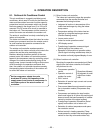
– 24 –
(3) Contents of operation command signal (Serial
signal) from indoor unit controller to outdoor unit
controller
The following three types of signals are sent
from the indoor unit controller.
• Operation mode set on the remote control
• Compressor revolution command signal defined
by indoor temperature and set temperature
(Correction along with variation of room
temperature and correction of indoor heat
exchanger temperature are added.)
• For these two types of signals ( [Operation
mode] and [Compressor revolution] ), the
outdoor unit controller monitors the input
current to the inverter, and performs the
followed operation within the range that
current does not exceed the allowable value.
• Temperature of indoor heat exchanger by indoor
heat exchanger sensor
(Minimum revolution control)
(4) Contents of operation command signal (Serial
signal) from outdoor unit controller to indoor unit
controller
The following signals are sent from the outdoor
unit controller.
• The current operation mode
• The current compressor revolution
• Outdoor temperature
• Existence of protective circuit operation
For transferring of these signals, the indoor
unit controller monitors the contents of signals,
and judges existence of trouble occurrence.
Contents of judgment are described below.
• Whether distinction of the current operation
status meets to the operation command
signal
• Whether protective circuit operates
When no signal is received from the
outdoor unit controller, it is assumed as a
trouble.
8-1-1. Capacity Control
The cooling and heating capacity is varied by
changing compressor motor speed. The inverter
changes compressor motor speed by changing AC
220–230–240V power to DC once, and controls
capacity by changing supply power status to the
compressor with transistor module (includes 6
transistors). The outline of the control is as follows:
The revolution position and revolution speed of the
motor are detected by detecting winding electromo-
tive force of the compressor motor under operation,
and the revolution speed is changed so that the
motor drives based upon revolution speed of the
operation command by changing timing (current
transfer timing) to exchange inverter output voltage
and supply power winding.
Detection of the revolution position for controlling is
performed 12 times per 1 revolution of compressor.
The range of supply power frequency to the com-
pressor differs according to the operation status
(COOL, HEAT, DRY).
Table 8-1-1 Compressor revolution range
8-1-2. Current Release Control
The outdoor main circuit control section (Inverter
assembly) detects the input current to the outdoor
unit. If the current value with compressor motor
speed instructed from indoor side exceeds the
specified value, the outdoor main circuit control
section controls compressor motor speed by reduc-
ing motor speed so that value becomes closest to
the command within the limited value.
8-1-3. Power Factor Improvement Control
Power factor improvement control is performed
mainly aiming to reduce the current on much power
consumption of cooling/heating operation. Control-
ling starts from the time when input power has
reached at a certain point. To be concrete, IGBT of
the power factor improvement circuit is used, and
the power factor is improved by keeping IGBT on for
an arbitrary period to widen electro-angle of the
input current.
Operation
mode
Model name
Compressor
revolution (rps)
10YKV-E 13 to 74
COOL
13YKV-E 13 to 94
10YKV-E 16 to 110
HEAT
13YKV-E 16 to 114


















